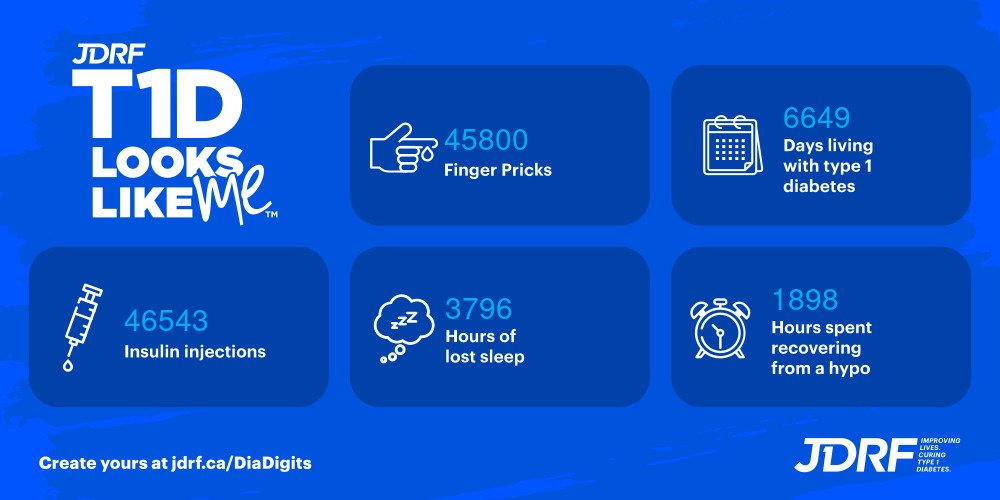Tips for Better Sleep with Type 1 Diabetes
Every year for International Diabetes Day, JDRF has this fun tool where you can put in your diagnosis date and whether you wear a CGM and/or an insulin pump and it will spit out your Diabetes Digits in a little infographic you can share on social media. The idea is to raise awareness of how “visible” diabetes is for those of us who live with it, even though it’s classified as an invisible illness. When I did mine for the first time a few years ago, I was a little surprised by the number of needles and blood pricks I’d done (46,543 and 45,800, respectively), but what really caught me off guard was the number of hours of sleep I’d apparently lost—3,796 hours over the 18 years I’d had type one. That’s equivalent to 475 nights of lost sleep, assuming an average of 8 hours a night!
Getting good sleep when you have diabetes is no easy feat, especially if you have devices like pumps and CGMs to account for. Some of the most common causes of lost sleep for me include:
Pump and CGM alerts
Getting caught or tangled within my devices
Treating highs
Treating lows
Tossing and turning due to diabetes fluctuations
Having to use the bathroom when my blood sugar is high
Pump site or CGM expiring at night
low battery alarms
Some of these are less common, but rolling on my pump (and subsequently waking up because it’s digging into me) or getting tangled within tubing happens almost every single night. Getting bad sleep is not something I’d wish on anyone, but it’s especially hard because not feeling rested impacts blood sugars for the rest of the day, creating a vicious cycle for those of us with diabetes.
I’m not a sleep expert by any means, but here are some of the tips I’ve learned over the years that help me to have better sleep!
Turn off Unnecessary Alarms
Your CGM and connected devices (in my case, my pump and iPhone) usually come with preset alarms for highs and lows, as well as to alert you to any connectivity issues, sensors expiring, tubing kinks, or anticipated highs or lows. I encourage everyone to go through all of their alarms on any diabetes devices and turn off the ones you don’t truly need at night. Check with your healthcare team if you’re not sure, but I turned off all optional alarms and only kept the required alarms you can’t turn off (urgent low alerts). I did the same for my pump and only kept alarms on for tubing issues, because I’d want to deal with those quickly if they came up. Otherwise, I don’t want to hear it at night!
2. Find a PJ situation that works for you
If you have a tubed insulin pump, I feel you. I was on a tubeless pump for several years before moving to a tubed pump (if you’re trying to decide between a tubed vs. tubeless design, check out this post on how to pick an insulin pump!). I made the switch because I liked the technology in the tubed pump better at the time, but the biggest downside was having to be attached 24/7 and having my sleep impacted. If you’re in the same boat, try getting some pyjamas that have pockets (ideally that button or zip closed), or use a belt or clip to keep your pump in one spot if you don’t roll around a lot. While my pump still sometimes falls out, starting the night with it in a pocket has really helped me reduce the amount of tangled tubing I have to deal with, subsequently making my sleep a lot better.
3. Get to know your nighttime patterns
One of the best ways to reduce diabetes drama impacting your sleep is to get to know your blood sugar and insulin patterns at night. I like to sit down every Sunday and review my CGM report from the week so I can notice any patterns, but sometimes I can tell after a night or two if something needs to change. If I notice a recent pattern of lows at night, I’ll reduce my insulin or have a snack the next night. For highs, I’ll look to see if I’m properly bolusing for my meals at dinner (higher fat and carb foods like pizza or sushi can cause spikes hours after bed) and try out extended boluses or give myself a bit of extra insulin before sleeping. By being proactive about noticing your patterns, you can get ahead of things that will continue to impact your sleep (and as a bonus, this will help your overall Time in Range since the night is a significant chunk of time).
An example of the trends I look at each week (this is an average, BTW. My blood sugars are not in a straight line like this each day #WishfulThinking)
4. Avoid intense exercise before bed
As a diabetic, exercise is one of those catch-22 situations sometimes. Physical activity is great, but it can also wreak havoc on your blood sugars if you’re not careful. Since intense exercise (HIIT, spin classes, boxing, etc.) can often cause a spike because of adrenaline followed by a crash a while later, exercising too close to bedtime can cause blood sugar issues later. If you are a fan of exercising at night or just didn’t get a chance to squeeze it in during the day (ahem, me!), opt for things like yoga, pilates, or lower-intensity strength workouts closer to bedtime to minimize blood sugar issues that will wake you up later.
5. Keep snacks and insulin near your bed
If you’ve ever had that experience of waking up knowing your blood sugar is high or low and then drifting in and out of sleep for a while until finally getting up to deal with it, you know why this tip is key. By having extra sugar and an insulin pen/vial and syringe/pump site change handy, you can deal with high or low diabetes situations quickly without having to leave the warmth of your bed. In my experience, this also means it’s much easier to fall back asleep when I’m ready to because I didn’t completely wake up by walking around. This is also great because wandering into the kitchen when you’re low almost always means overtreating and eating too much sugar because it’s just too hard to say no when all the food is there. I once woke up and ate half of our gingerbread house because it was sitting there and I was really low and my brain just couldn’t make me stop. The rebound high after that was legendary (haha).
***
I hope these tips help you sleep a bit better if you’ve been struggling as someone living with diabetes. If you have any additional tips, let me know because I’m always looking for ways to continue improving and love trying new suggestions!



